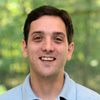Dynamic Response of the Environment At the Moon
 |
Michael Zimmerman
1. What is your role on the DREAM team?
I am a NASA Postdoctoral Fellow using computer simulations to study the interaction between the solar wind plasma and the dynamic lunar surface.
2. What about DREAM do you find most interesting? Most challenging?
I find the rich complexity of the lunar day-night boundary (the terminator) to be fascinating. I am particularly interested in characterizing the electrical environment in near-terminator shadowed craters. We've shown through computer simulations that as the solar wind flows horizontally past a shadowed crater it creates a plasma wake. Interestingly, the wake interacts with the surface in a way that can dramatically shape the local electric field, which then feeds back on the inflowing plasma. The most challenging aspect is casting these results within the broader context of DREAM, that is, understanding how thermal, chemical, and electrical processes compete to govern the local environment.
3. What other NASA programs or missions have you participated in?
None yet; however, I hope to become involved with other programs/missions as time goes on.
4. What kind/level of education do you have?
B.S. in Computer Science/Physics with a minor in Mathematics from Frostburg State University in Western Maryland. M.S. and Ph.D. in Physics from West Virginia University, where I focused on experimental plasma physics and computational tornado dynamics.
5. What advice do you have for students who want to work for NASA or on NASA-related research?
I think it is of utmost importance to work hard in your courses to get the fundamentals down. Spend a few semesters working for different research groups to see what area you might like best. Get involved in a NASA co-op program. Working for NASA is a blast!
6. What are your favorite things to do outside of work?
Spending time with my wife and two preschool-age sons, biking, reading, playing guitar, hobby-level programming and microelectronics.

